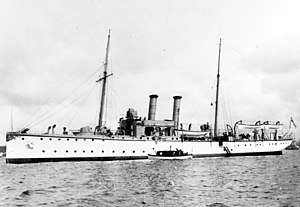
SMS Seeadler was an unprotected cruiser of the Bussard class, the third member of a class of six ships built by the German Kaiserliche Marine. Her sister ships included Bussard, the lead ship, along with Falke, Condor, Cormoran, and Geier. Seeadler was built at the Kaiserliche Werft in Danzig in late 1890, launched in February 1892, and commissioned in August of that year. Intended for colonial service, Seeadler was armed with a main battery of eight 10.5-centimeter (4.1 in) guns and had a top speed of 15.5 knots.
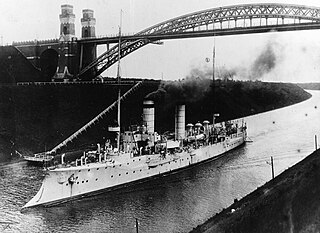
SMS Arcona was the ninth member of the ten-ship Gazelle class of light cruisers that were built for the German Kaiserliche Marine in the late 1890s and early 1900s. The Gazelle class was the culmination of earlier unprotected cruiser and aviso designs, combining the best aspects of both types in what became the progenitor of all future light cruisers of the Imperial fleet. Built to be able to serve with the main German fleet and as a colonial cruiser, she was armed with a battery of ten 10.5 cm (4.1 in) guns and a top speed of 21.5 knots. Arcona was a modified version of the basic Gazelle design, with improved armor and additional coal storage for a longer cruising range.

SMS Bremen was the lead ship of the seven-vessel Bremen class of light cruisers, built for the German Kaiserliche Marine in the early 1900s. She and her sister ships were ordered under the 1898 Naval Law that required new cruisers be built to replace obsolete vessels in the fleet. The design for the Bremen class was derived from the preceding Gazelle class, utilizing a larger hull that allowed for additional boilers that increased speed. Bremen was armed with a main battery of ten 10.5 cm (4.1 in) guns and had a top speed of 22 knots.
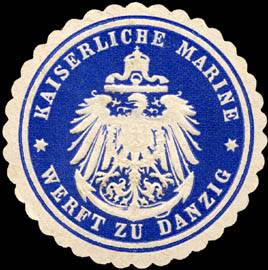
Kaiserliche Werft Danzig was a German shipbuilding company founded in 1852 as Königliche Werft Danzig and renamed Kaiserliche Werft after the proclamation of the German Empire in 1871. Together with Kaiserliche Werft Kiel and Kaiserliche Werft Wilhelmshaven it was one of three shipyards responsible for maintenance, repair and construction of warships for the Imperial German Navy. Kaiserliche Werft Danzig closed in 1918 after the end of World War I, but soon opened when Danziger Werft was founded on its site in 1919.

Kaiserliche Werft Wilhelmshaven was a German shipbuilding company in Wilhelmshaven, founded in 1871 and closed in 1918. Together with Kaiserliche Werft Danzig and Kaiserliche Werft Kiel it was one of three shipyards which solely produced warships for the Preußische Marine and the following German Kaiserliche Marine. With the end of World War I all three imperial shipyards were closed, but the Wilhelmshaven shipyard was reopened in 1919, first as Reichsmarinewerft Wilhelmshaven, and after 1935 named Kriegsmarinewerft Wilhelmshaven.

SMS Vineta was a protected cruiser of the Victoria Louise class, built for the German Imperial Navy in the 1890s. Vineta was laid down at the AG Vulcan shipyard in 1895, launched in April 1897, and commissioned into the Navy in July 1898. The ship, named for the semi-legendary medieval town of Vineta, was armed with a battery of two 21 cm guns and eight 15 cm guns and had a top speed of 19 knots.
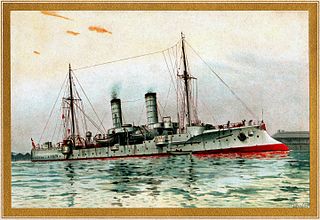
SMS Gazelle was the lead ship of the ten-vessel Gazelle class of light cruisers that were built for the German Kaiserliche Marine in the late 1890s. The Gazelle class was the culmination of earlier unprotected cruiser and aviso designs, combining the best aspects of both types in what became the progenitor of all future light cruisers of the Imperial fleet. Built to be able to serve with the main German fleet and as a colonial cruiser, she was armed with a battery of ten 10.5 cm (4.1 in) guns and a top speed of 19.5 knots. Her Niclausse boilers proved to be troublesome in service, and these were later replaced in the mid-1900s.
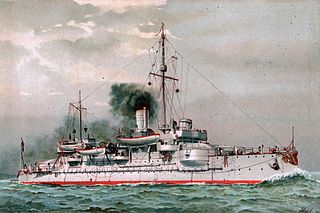
SMS Hagen was the final vessel of the six-member Siegfried class of coastal defense ships built for the German Imperial Navy. Her sister ships were Siegfried, Beowulf, Frithjof, Heimdall, and Hildebrand. Hagen was built by the Kaiserliche Werft in Kiel between 1891 and 1893, and was armed with a main battery of three 24-centimeter (9.4 in) guns. She served in the German fleet throughout the 1890s and was rebuilt in 1900 - 1902. She served in the VI Battle Squadron after the outbreak of World War I in August 1914, but saw no action. Hagen was demobilized in 1915 and used as a barracks ship thereafter. She was ultimately sold for scrap in 1919 and subsequently dismantled.

SMS Berlin was the second member of the seven-vessel Bremen class of light cruisers, built for the German Kaiserliche Marine in the early 1900s. She and her sister ships were ordered under the 1898 Naval Law that required new cruisers be built to replace obsolete vessels in the fleet. The design for the Bremen class was derived from the preceding Gazelle class, utilizing a larger hull that allowed for additional boilers that increased speed. Named for the German capital of Berlin, the ship was armed with a main battery of ten 10.5 cm (4.1 in) guns and had a top speed of 22 knots.
Heinrich Paul Christian Richard Eckermann was an officer of the German Imperial Navy, rising to Vizeadmiral in the First World War.
The Markomannia incident was a conflict between Haitian rebels and the German Empire in 1902, sparked by the boarding of the Hamburg steamer Markomannia by rebel naval forces.

SMS Falke was an unprotected cruiser of the Bussard class, built for the Imperial German Navy. She was the second member of the class of six vessels. The cruiser was laid down in 1890, launched in April 1891, and commissioned into the fleet in September of that month. Designed for overseas service, she carried a main battery of eight 10.5-centimeter (4.1 in) guns and had a top speed of 15.5 knots.

SMS Cormoran was an unprotected cruiser of the Bussard class, the fifth member of a class of six ships. She was built for the Imperial German Navy for overseas duty. The cruiser's keel was laid down in Danzig in 1890; she was launched in May 1892 and commissioned in July 1893. Cormoran was armed with a main battery of eight 10.5-centimeter (4.1 in) guns, and could steam at a speed of 15.5 knots.

SMS Schwalbe was an unprotected cruiser built for the German Kaiserliche Marine, the lead ship of the Schwalbe class. She had one sister ship, Sperber. Schwalbe was built at the Kaiserliche Werft in Wilhelmshaven; her keel was laid down in April 1886 and her completed hull was launched in August 1887. She was commissioned for service in May 1888. Designed for colonial service, Schwalbe was armed with a main battery of eight 10.5-centimeter (4.1 in) guns and had a cruising radius of over 3,000 nautical miles ; she also had an auxiliary sailing rig to supplement her steam engines.

Crête-à-Pierrot was a gunboat in the Haitian Navy named after the 1802 Battle of Crête-à-Pierrot in the Haitian Revolution. The boat was destroyed by Admiral Hammerton Killick in 1902 to prevent it falling into the hands of a German warship.

SMS Luchs was the fourth member of the Iltis class of gunboats built for the German Kaiserliche Marine in the late 1890s and early 1900s. Other ships of the class are SMS Iltis, SMS Tiger, SMS Eber, SMS Jaguar and SMS Panther.

SMS Tiger was the third member of the Iltis class of gunboats built for the German Kaiserliche Marine in the late 1890s and early 1900s. Other ships of the class were SMS Iltis, SMS Luchs, SMS Eber, SMS Jaguar and SMS Panther.

HMS Castle Harbour was a civilian harbour vessel of 730 tons that was taken-up from trade (TUFT) during the Second World War by the Royal Naval Dockyard in Bermuda for use by the Royal Naval Examination Service and later armed and commissioned as a warship, providing harbour defence from submarines.
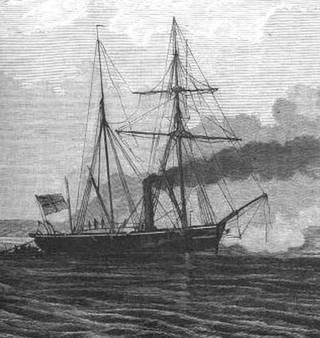
SMS Cyclop was a Camäleon-class gunboat of the Prussian Navy that was launched in 1860. A small vessel, armed with only three light guns, Cyclop served during the three wars of German unification; during the first, the Second Schleswig War on 1864, she guarded the Prussian coastline but saw no action. She supported the army's campaign against the Kingdom of Hanover during the Austro-Prussian War of 1866, and she defended the Elbe for the duration of the Franco-Prussian War of 1870–1871, but again took part in no battles. Badly deteriorated by 1872, she was stricken from the naval register in March that year and reconstructed into an iron-hulled gunboat. Recommissioned in 1875, she thereafter served abroad in the German colonial empire before being stricken again in 1888. She was thereafter used as a storage hulk before ultimately being broken up for scrap after 1914.
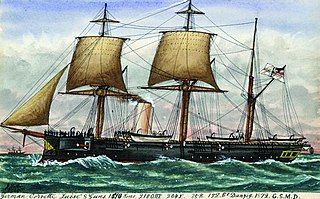
SMS Luise was a steam corvette of the German Kaiserliche Marine. She was the second member of the Ariadne class, which included two other ships, Ariadne and Freya. Ordered as part of a large naval expansion program after the Austro-Prussian War, she was laid down in 1871 during the Franco-Prussian War. She was launched in December 1872 and completed in June 1874. Luise was a small vessel, armed with a battery of just eight guns.
